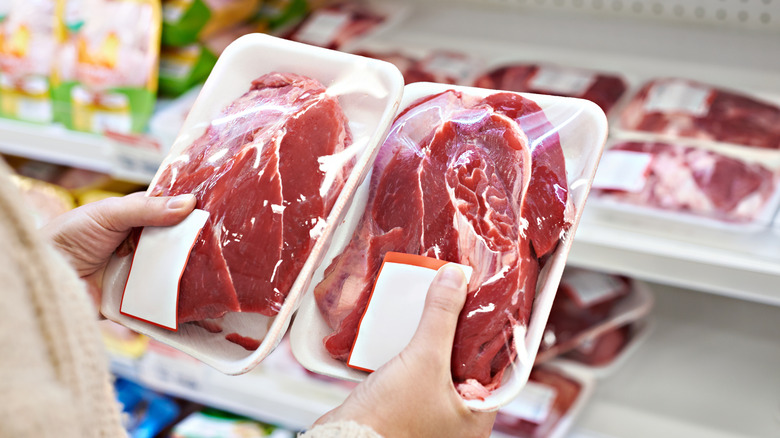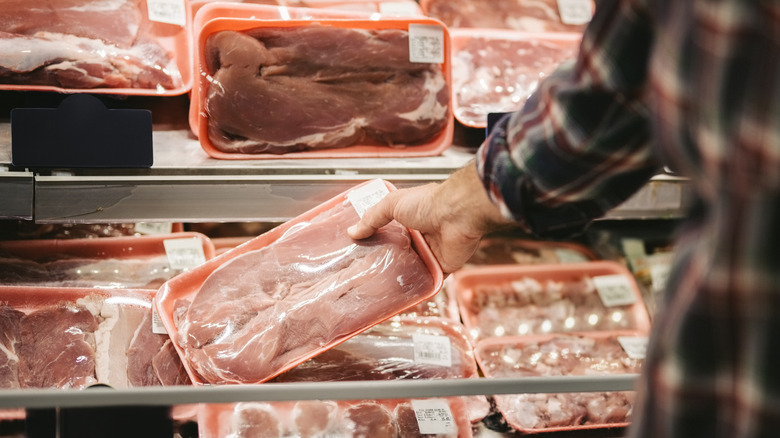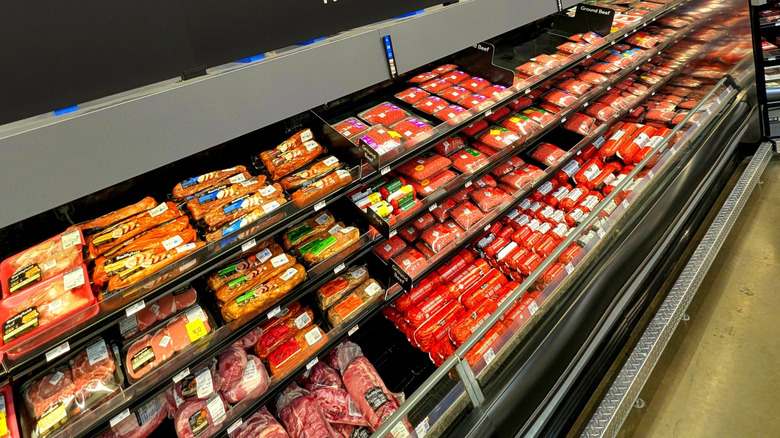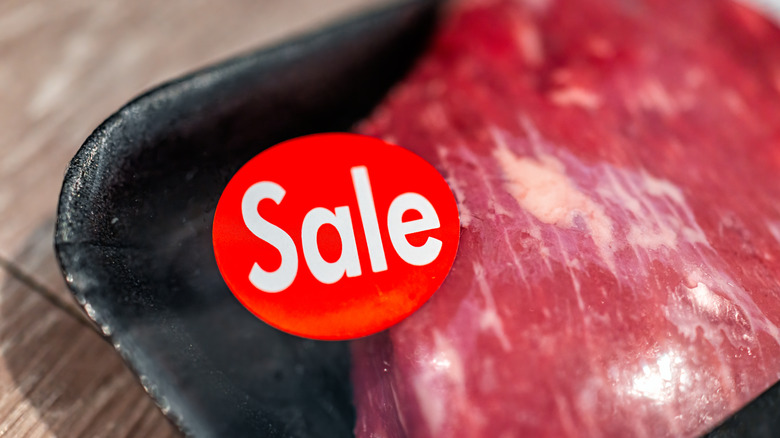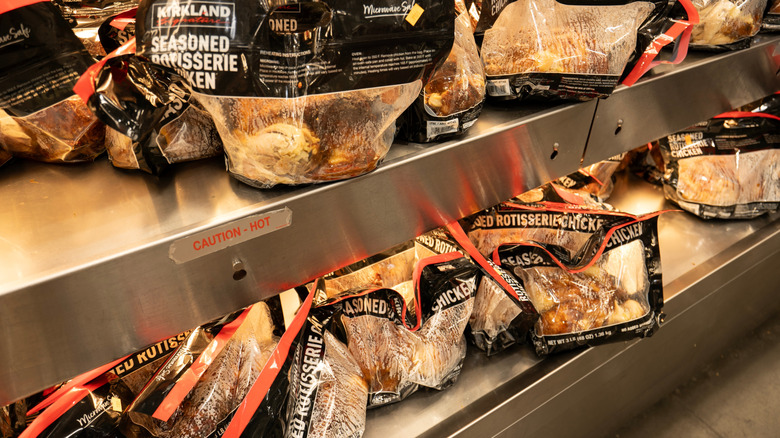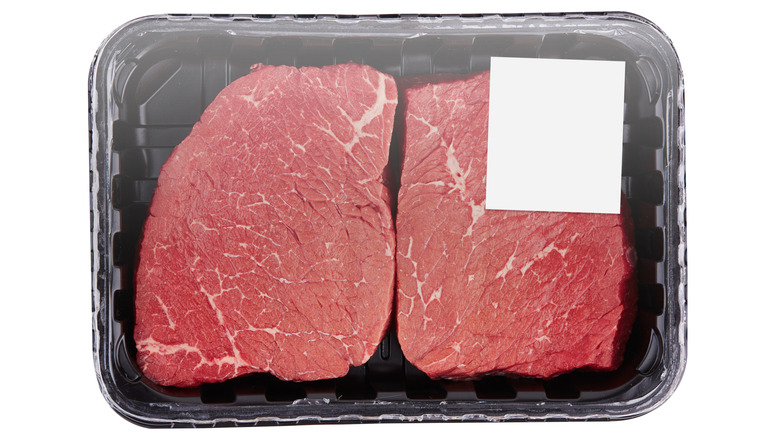Meat Department Red Flags To Look Out For
The meat counter at your local grocery store is a common place to stop during weekly shopping excursions. With a quick glance, supermarket meat departments may appear to be professionally operated and stocked with quality products — but it's always worthwhile to take a closer look to answer the nagging question: is the meat safe?
The good news is that the U.S. Department of Agriculture carries out oversight of meat-safety regulations, including how stores should sell meat to customers in regard to quality and food safety. You will find that grocery stores generally adhere to these safety guidelines, and some chains have their own meat department policies in place that can be even more strict than federal requirements.
Additionally, some concerns raised by consumers about meat department safety are the result of misconceptions. For example, meats on clearance are suspected of being unsafe, because many people believe that meat nearing its expiration date is of lesser quality — but in reality, it is typically still perfectly safe to eat. However, that's not to say there aren't some less-than-ideal meat department situations out there. Because of that, we spoke with experts to learn about what to be aware of at supermarket meat departments. Armed with expert knowledge and some tips for getting high-quality meat, if you look out for the following red flags, you can rest assured that your chosen protein is both delicious and safe.
The meat has bloated packaging
One of the first things you notice when selecting meat is its packaging. Packaging that appears to be bloated or puffier than usual has long been considered a red flag, as it may indicate that the meat has some bacterial growth. This can happen when the meat is exposed to active microbes, which then leads to gas formation, increasingly inflating the packaging the longer the meat sits.
However, bloated packaging isn't necessarily always bad, as some sealing and containment techniques can make the packaging appear bloated. "It's true that some bulging vacuum seals may indicate the meat is older, but there are other types of seals that are very tight that customers may confuse for being bulging," says meat expert Jess Pryles — aka the Hardcore Carnivore — while adding that customer confusion over the tighter seals can result in wasted meat. One of the common packaging methods is modified atmosphere packaging (MAP), which introduces oxygen, carbon dioxide, and nitrogen into the packaging at the time of sealing to extend the meat's shelf life. This can give the impression of some swelling in the package.
While bloated packaging doesn't always mean that you should bypass meat at the supermarket, it is reason enough for a closer look. If you suspect it was caused by bacteria, experts say to check for foul odors or if the package is torn, as well as the expiration date. If any of these are questionable, move on from this meat.
Meat packages filled with liquid
Another sign to be aware of when selecting meat at the supermarket is liquid that may be found inside the packaging. You have likely seen raw meat in containers with some pink or reddish juices pooling at the bottom. Don't panic — this is not blood, as that is removed during commercial meat processing.
The excess liquid is actually water that leaks out of meat — which is mostly composed of water — combined with a protein called myoglobin, which together create the reddish fluid found in meat packaging. This is a natural occurrence, but the problem lies in how long the package is sitting in the store, as the meat proteins lose their ability to retain water as the meat ages, or if it is excessively handled.
With this in mind, spotting an excessive amount of this liquid in the package can be an indicator that the meat has been awaiting a buyer for a long time. Combined with other clues, like the color of the meat, that can be a red flag. "Generally, you want meat that doesn't appear to be starting to [turn] brown/gray on the outside, or leaching a lot of liquid," says Jess Pryles. "These may be indications that they are older or have been out for a while."
Packages of meat that are damaged or torn
This red flag may seem like an obvious one, but it is important to pay attention to the integrity of your meat's packaging. A torn or punctured package means the meat has likely been exposed to air, thus creating a breeding ground for bacteria.
In this situation, not only is the meat no longer safe to eat, but the package could also be contaminating other groceries if it has already been added to your cart. "Leaks and juices on the outside are very important — and often ignored — things to look for in packaging, since these juices contain bacteria, which can spread to other surfaces," said food scientist Bryan Quoc Le, founder and principal food consultant at Medocino Food Consulting. "For example, if you put a leaking package in your cart, and then grab a bottle of ketchup, that ketchup bottle is now contaminated, which is a risk for when you use ketchup on your fries or burger at home, which are eaten with your hands." And while the occasional torn or damaged package can happen by accident, you will want to take note if compromised packaging becomes a common sight at your grocer's meat department.
The meat department looks unclean
Cleanliness should be a top priority in most customer-facing businesses — but it is even more important when it comes to the food industry. Numerous local and state-level agencies are tasked with ensuring that all retail businesses that handle food are continually maintaining hygienic facilities, which must be regularly cleaned to prevent the spread of foodborne illnesses. Health inspectors carry out regular on-site checks to confirm that supermarkets are compliant with regulations.
Because of this, your local grocer's meat counter should be (and likely is) following rigorous cleanliness practices to promote a clean environment, which experts say is crucial to preserving the retailer's good reputation, leading to more sales. However, there are some red flags to look out for that can point to some serious sanitary issues happening in the meat department.
"Two of the most worrying signs are small pieces of meat on and in places where they don't belong, such as on surfaces that are touched by customers, and meat that is outside of refrigeration for too long," said Bryan Quoc Le. "The former is a risk for the spread of pathogenic bacteria, and the latter is a risk for the meat to spoil."
Employees don't take food safety precautions
It's not a secret that raw meats and seafood can be potential sources for bacteria that lead to foodborne illnesses. Because of this, necessary precautions should be taken to prevent contamination, which includes careful control of employee work clothing and protective gear.
Supermarket managers frequently enforce rigid policies and standards for employees who handle food directly, including what workers wear in the meat department. According to Jess Pryles, "hairnets, beardnets, and gloves are a must." But if you see that grocery store butchers have stains on their aprons, that may actually be considered a good thing. "In grocery stores where they cut the meat fresh (which is desirable), it's totally possible that a butcher may have various meat stains on their apron. It doesn't mean that their apron isn't fresh, it just means that they've been doing their job," Pryles added.
Bryan Quoc Le agrees that you should anticipate stains and juices on aprons, as meat department employees are working around messy items. He says what may be more of a red flag is an employee's clothing beneath the apron. "If there are any stains on their clothes underneath, then that could indicate that they were not wearing the proper attire while working," Le says. "As for gloves, hairnets, and other disposables, these are expected to get dirty, although hairnets should be clean most of the time."
Meat is improperly stored
Improper storage is a big no-no for meat in general. This means that meats should be kept at 40 degrees Fahrenheit or below to prevent bacterial growth. To remain in compliance with this requirement, grocery store meat departments should have temperature-monitoring devices in their refrigerators, like digital thermometers or data loggers, to record temperatures over time.
Supermarket managers generally establish standard operating procedures to determine how often temperatures are monitored, data recording procedures, and what actions are taken if temperatures don't meet the requirements. If you notice that the meat department has no temperature-recording device — or if so, that the temperature is not at 40 degrees Fahrenheit or lower — that is a red flag.
Other factors of supermarket storage, like packaging, can help with keeping meat fresh. "There's a variety of packaging (such as MAP, vacuum seal, etc.) that really extends the shelf life of meat," says Jess Pryles, adding that the most important factor for food safety is keeping meat cold. On that note, after buying meat from the grocery store, the way that you store it at home is also important. "Meat should be wrapped to prevent drying, and stored in the back of the fridge where it is coldest, on the lowest shelf, in case leaking occurs, so that the juices do not contaminate other items," says Bryan Quoc Le.
You smell an odor in the meat department
There is nothing quite as distinctively repulsive as the smell of spoiled meat. Fresh meat shouldn't have any aroma, so if the supermarket's meat department has one, that is not a good sign. "Color and use-by dates in meat are all subjective and relative. But smell never lies! A foul, off-putting smell in meat is the absolute best way to know that it has turned. The same could be said of the meat department," says Jess Pryles, adding that the store's meat section shouldn't have any particular odor at all. "If you smell anything that makes you scrunch up your nose, that's a problem."
While a foul odor in a grocery store meat department is a red flag, the corresponding actions (or lack thereof) by management can be telling when assessing how the supermarket is operating in general. "If the customer notices odors, then so do the workers, and if it's not being addressed, then that indicates a problem with management and the overall operations in the department," says Bryan Quoc Le. Needless to say, if you note an unsavory smell in the meat department, steer clear of its products — and consider shopping at another grocery store altogether.
A lot of the meat is marked down
This red flag can be considered controversial, as there are many reasons why grocery store meat departments mark down meat, and they are not necessarily for bad reasons. "Meat is often marked down when it approaches its expiration date so that it encourages sales and minimizes waste. Stores do this because it's better for them to make some profit than to throw away these products," says Bryan Quoc Le.
It's also important to note that expiration dates on meat are not necessarily accurate. "There are usually no set guidelines or expiration dates for meat. There's no magic number that says that one particular steak is going to go bad by or on a certain day," says Jess Pryles. "There are so many variables that can contribute to how quickly it goes bad. 'Best before' dates are set and adhered to by the store itself, and it's just smarter for them to operate cautiously."
Nonetheless, if a piece of meat is discounted because it is nearing its sell-by date, then it is inherently not as fresh as the full-priced options in the meat department. And if a considerable amount of meat is marked down across the entire department, this could be an indication of poor supermarket management in regards to ordering and overstocking. These are just a couple reasons why meat can be included among grocery store items to skip when they're on sale.
Ready-to-eat meat products are overstocked
Meat departments in large grocery store chains offer much more than raw beef, poultry, and pork at the butcher counter. Ready-to-eat options like rotisserie chickens are popular for grab-and-go dinners. You may be thinking that an array of choices is a good thing, right?
Think again. One of the red flags to look out for when buying a grocery store rotisserie chicken is an overabundance of them in stock, which can mean that there isn't a lot of turnover of this product, so the case isn't being refreshed throughout the day. While this isn't necessarily a bad thing if you see it one time during a store visit, take notice if you are regularly seeing ready-to-eat meat items piling up. Whether it's a question of poor quality or just a lack of demand, a keen eye on the prepared food section can help ensure that you are getting the freshest options.
Additionally, if you are curious about the freshness of any specific meat offering, don't be afraid to ask questions of your store's workers. "Because delivery schedules vary for each store, the only way to know when the freshest meat is available is to ask the employees," says Bryan Quoc Le.
Packages appear to have labeling issues
You may not realize that the packaging for meats isn't solely left up to the discretion of a supermarket's meat department. Federal authorities have oversight of what exactly is included on meat-packaging labels, and requirements are in place for grocers that should be followed rigorously. The required labeling information usually includes the product name, the official inspection legend (with the establishment number for the processing facility), an address line, the net weight or quantity, and an ingredients list that should indicate the presence of allergens. Since this is a food safety requirement, if a meat package is missing this kind of informative label, that would be cause for pause.
Marketing information on labels is another factor to consider. Special approval is required by the USDA if the packaging notes how the animal was raised, its living conditions (such as free range or pasture raised), and diet (like whether it was grass-fed or grain-fed). This is a good reason to learn about common phrases on beef packages and what they mean — and it's worth asking meat department employees to provide more information if anything seems unclear. If the worker can't offer a convincing answer, you may want to question just how professionally this supermarket is being operated.
Meat packages have ice crystals
Your meat department may sell already-frozen meat options, but often, supermarkets with in-house butchers will specialize in fresh, never-frozen meat. While it is perfectly safe to freeze and thaw meat, the meat inside the package shouldn't have ice crystals, whether it's at the store or at home. These tiny ice crystals are called freezer burn, and they occur when moisture is pulled out of food. This, in turn, affects the texture of the meat, making it tough and dry. Technically, food with freezer burn is safe to eat, but the ice crystals can diminish meat's quality, which is disappointing. Freezer burn can also cause grayish-brown spots on food, so you'll want to be on the lookout for discoloration in packaged meat.
Those pesky ice crystals can be a sign that the meat wasn't stored properly. While you can freeze meat in its original packaging, the wrapping can be permeable and allow air through, causing quality to suffer. And it's not just still-frozen meat that can have those ice crystals. Fresh meat with ice crystals can be a sign that the meat was previously frozen and is thawing while on display. This may not mean that the meat is inedible, but it shows that the store's management cares little about its presentation.


